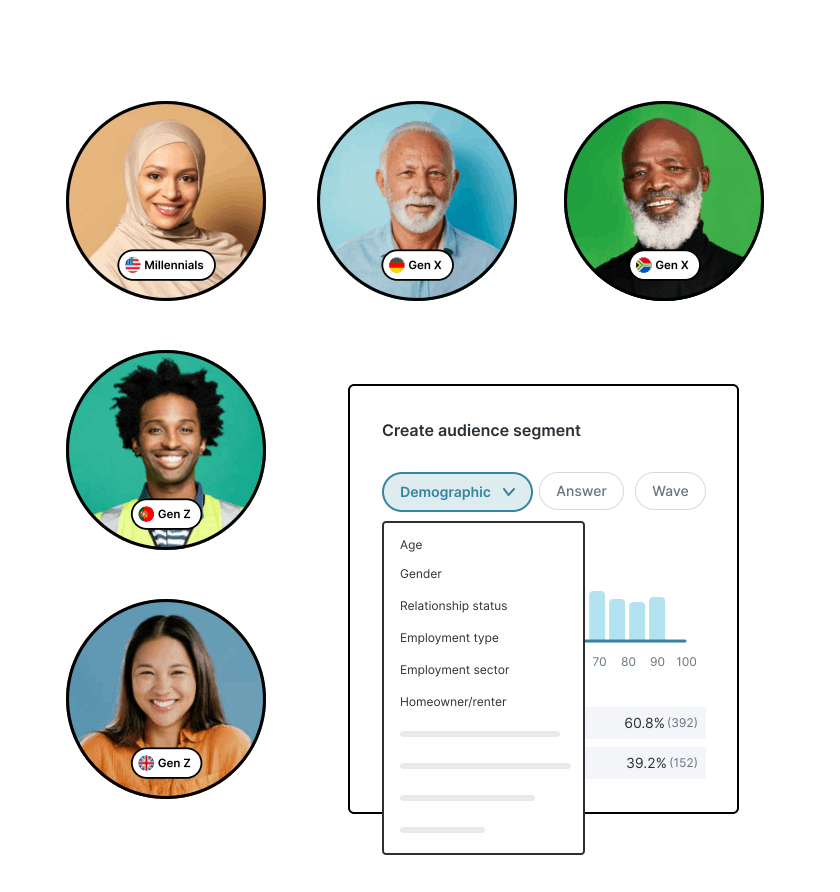52 Consumer behavior survey questions for expert customer insights

Most consumers don’t realize the patterns in their purchasing habits. We don’t know (or want to know) just how impulsive we really are. Unprompted, we don’t think all too much about what or who influences our buying (apart from when you’re sure Instagram is listening to you and you get creepily well-targeted ads).
But as a business, knowing all about consumer behavior is incredibly valuable. You’ll be one step ahead every time, ready to delight consumers—and ideally turn them into fans who’ll rave about you to their friends and family.
One way to find out what consumer behavior is most relevant to your business is with a consumer behavior questionnaire. And we’re here to help you create a great one.
A consumer behavior survey is a type of market research that helps you gather information on consumer attitudes, preferences, and behaviors.
These insights allow you to tailor your products, services, strategies and marketing to your customers’ needs to increase sales, customer satisfaction and gain a competitive edge.
Here we’ll give you 52 questions to include in your next market research.
First up let’s make sure we’re on the same page…
What do consumer behavior surveys do?
Understanding your customers’ behaviors is one of the most important things for a successful brand.
Consumer behavior surveys are a tool to help you delve into the ‘why’ and ‘how’ behind purchasing decisions. By exploring factors such as motivations, preferences, and influences, these surveys provide primary consumer data that lets you tailor your products, services and marketing strategies effectively.
Engaging directly with your audience through well-crafted questions not only uncovers valuable data but also fosters a deeper connection with your target customers.
52 Consumer behavior survey questions to ask your customers
If you’re looking to gather data about purchase behavior using online surveys, you’ll want to use a mix of close-ended and open-ended questions. This mix of survey questions enables you to gather reliable consumer insights through tangible data (through closed-ended questions), and provides context for why your potential customers do things in certain ways (through open-ended questions).
Using our Customer Research Team’s vast experience helping brands carry out reliable consumer behavior market research, we’ve gathered these example questions.
It’s important to note that this is not a copy-paste survey: you should be creating one that is specific to your research goals and business. These questions merely serve as inspiration.
Here’s a brief rundown of the behavior questions we’ll cover in this guide:
- Purchase frequency and patterns
- Decision-making factors
- Information channel preferences
- Payment preferences
- Brand loyalty and satisfaction
- Shopping habits
- Price sensitivity
- Product usage
- Post-purchase behavior
- Demographic information
And with that, let’s dive into the most insightful survey questions.
Learn how customers make buying decisions
Get data into how your customers behave – and buy!—with Attest’s Jobs to be Done survey template, written by research experts.
Get your insightsQuestions for purchase frequency and patterns
With these questions you can understand how often people buy and when they purchase. They can help you with commercial and marketing strategies, and with identifying peak buying periods.
- How often do you purchase [PRODUCT]?
- When was the last time you purchased [PRODUCT]?
- Do you prefer to purchase [PRODUCT] on weekdays or weekends?
- What time of day do you usually shop for [PRODUCT]?
- Do you buy [PRODUCT] more during specific seasons or holidays?
Decision-making factors
People buy things for all kinds of reasons – price, quality, convenience and brand reputation to name a few.
These questions get to the heart of what matters most to your customers, so you know what to emphasize and where you might need to improve.
- What factors influence your decision to purchase [PRODUCT]?
- How important is price in your decision to buy [PRODUCT]?
- Does brand reputation affect your choice of [PRODUCT]?
- How does product quality impact your purchasing decision?
- Are eco-friendly or sustainable practices important when choosing [PRODUCT]?
Information channel preferences
Where do your customers go to learn about your product? These questions will help you figure out which channels – like social media, online reviews or word of mouth – are most influential, so you can focus your efforts in the right places.
- What channels do you typically use to learn about [PRODUCT]?
- Do you rely on social media for information about [PRODUCT]?
- How often do you use online reviews to inform your purchase of [PRODUCT]?
- Do you seek recommendations from friends or family before buying [PRODUCT]?
- Which websites or blogs do you consult for information on [PRODUCT]?
Payment preferences
Knowing how people like to pay makes it easier for you to create a smooth checkout experience. These questions will show you whether your customers prefer credit, debit, digital wallets, or newer payment options.
- What is your preferred method of payment for [PRODUCT]?
- Do you use digital wallets or mobile payment options for purchasing [PRODUCT]?
- How likely are you to use buy now, pay later services for [PRODUCT]?
- Do you prefer using credit or debit cards for buying [PRODUCT]?
- Are you open to using cryptocurrency for purchasing [PRODUCT]?
Brand loyalty and satisfaction
Happy, loyal customers keep your business strong. These questions dig into how satisfied people are with your product and how likely they are to stick with your brand – or recommend you to others.
- How satisfied are you with [PRODUCT]?
- How likely are you to recommend [PRODUCT] to others?
- Do you consider yourself loyal to [BRAND]?
- Have you switched from a competitor to [BRAND]? If so, why?
- What would make you switch to a different brand for [PRODUCT]?

Shopping habits
People shop in different ways, and understanding those habits lets you meet them where they are.
These questions help you find out if your customers prefer online or in-store shopping, mobile apps, subscriptions or delivery services.
- Do you prefer shopping online or in physical stores for [PRODUCT]?
- How often do you use mobile apps to purchase [PRODUCT]?
- Do you subscribe to any subscription services for [PRODUCT]?
- How important is convenience in your shopping experience for [PRODUCT]?
- Do you use curbside pickup or home delivery services for [PRODUCT]?
Price sensitivity
Some people hunt for bargains, while others are willing to pay more for quality or convenience.
These questions will help you understand how much price impacts purchasing decisions and how your pricing stacks up.
- What is your typical budget for [PRODUCT]?
- How do discounts or promotions influence your decision to buy [PRODUCT]?
- Would you pay more for a premium version of [PRODUCT]?
- How do you feel about the current price of [PRODUCT]?
- Do you compare prices from different brands before purchasing [PRODUCT]?

Product usage
It’s one thing for someone to buy your product – it’s another for them to actually use and love it.
These questions help you understand how often and why people use your product, and how it fits into their lives.
- How often do you use [PRODUCT] after purchasing?
- What do you primarily use [PRODUCT] for?
- Have you discovered any alternative uses for [PRODUCT]?
- Do you use [PRODUCT] alone or with other products?
- How does [PRODUCT] fit into your daily routine?
- How likely are you to repurchase [PRODUCT] after your initial use?
- Have you ever recommended [PRODUCT] to someone else? If not, what would make you more likely to?
Post-purchase behavior
What happens after someone buys your product?
These questions help you understand how often people leave reviews, make returns, join loyalty programs or reach out for support – and how you can make their post-purchase experience even better.
- Have you ever returned or exchanged [PRODUCT]? If so, why?
- Do you leave reviews after purchasing [PRODUCT]?
- How likely are you to participate in loyalty programs for [PRODUCT]?
- Do you follow [BRAND] on social media after purchasing [PRODUCT]?
- Have you contacted customer service regarding [PRODUCT]? If so, how was your experience?
Demographic information
Who exactly are your customers?
These questions give you a clearer picture of the people buying your product, so you can tailor your messaging and strategy to the right audience.
And you can use questions like these to cut your data by whichever demographics matter most to you and your business.
- What is your age?
- What is your gender?
- What is your highest level of education?
- What is your annual household income?
- In which region or city do you reside?

Best practices for creating consumer behavior surveys
From our research experts, here are a few pointers and best practices to help you make the most of your consumer behavior research.
- Know your goal before you write a single question. If you don’t know what you’re trying to learn, your survey won’t be focused—and your results won’t be useful. Get clear on your objective first.
- Keep your survey focused and relevant. Resist the temptation to ask everything at once. Stick to the questions that will directly help you understand your customers better.
- Use a mix of open-ended and close-ended questions. Open-ended questions give rich, detailed answers but take more effort to analyze. Close-ended questions are quicker and easier to compare at scale. Use both where they make sense.
- Avoid leading or biased questions. Make sure your questions aren’t pushing people toward a particular answer. Keep them neutral so you get honest feedback.
- Keep the language clear, simple, and jargon-free. Write like a human. Avoid technical terms or industry language your audience might not understand.
- Offer balanced answer choices for multiple-choice questions. Cover a full range of possible responses so people don’t feel forced into picking an option that doesn’t fit.
- Use rating scales consistently throughout the survey. If you’re using scales (like 1 to 5 or 1 to 10), keep them consistent so people don’t get confused.
- Make sure every question adds real value. Ask yourself why each question is there and what you’ll do with the answer. If you don’t know, cut it.
- Test your survey before sending it out. Run it by a few people internally first to catch confusing wording or technical glitches.
- Keep it short – respect people’s time. The longer your survey, the more people will drop out before finishing. Stick to the essentials.
Make customer data analysis easy with Attest
Running consumer behavior surveys is simple, using Attest. We provide you with everything you need to learn about the moves, motives and motivations of your target audience. Your dedicated research expert will help you to get the best insights from your data so you can greatly benefit from consumer profiling. See our consumer profiling survey template for further ideas.

Get reliable consumer behavior insights
Make sure you gather consumer insights that are genuinely useful with our survey templates—written by our experts in the Customer Research Team
Open survey templatesTell us what you think of this article by leaving a comment on LinkedIn.
Or share it on:
